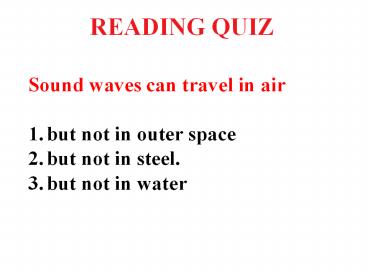READING QUIZ - PowerPoint PPT Presentation
Title:
READING QUIZ
Description:
READING QUIZ Sound waves can travel in air but not in outer space but not in steel. but not in water Light travel much, much faster than sound. Sounds take ~5 second ... – PowerPoint PPT presentation
Number of Views:18
Avg rating:3.0/5.0
Title: READING QUIZ
1
READING QUIZ
- Sound waves can travel in air
- but not in outer space
- but not in steel.
- but not in water
2
Physics Help Center Room 237 Physics Building
8am to 530pm Ask for help from graduate students
on homework and exams Can enter solutions on the
computers in the room to check your
solution. NEXT EXAM Wednesday April 7th _at_7pm to
9pm Chapters 10,11,12,13,14,15
3
Consider a guitar string which is one meter
long, and produces a note at 440 Hz when plucked
from the center.
Where should the string be held to produce a note
with frequency of 660 Hz?
4
The induced current in the loop of wire produces
an upward magnetic field inside the loop that
opposes the increase in the downward field
associated with the moving magnet.
5
(No Transcript)
6
Variations in air pressure (and density) move
through the air in a longitudinal sound wave.
The graph shows pressure plotted against
position.
Speed of Sound 1100 ft/sec (340 m/sec) 750 miles
per hour
Note the velocity of sound depends on the
medium. It is faster in water than in air, and
faster yet in steel.
7
- Light travel much, much faster than sound.
- Sounds take 5 second to travel 1 mile
- Sounds take 3 second to travel 1 kilometer
8
- Quiz Question 1
- A piano key produces a note with frequency f
440 Hz. What is the wavelength of the sound wave
this produces in air? - 0.77 m
- 1.3 m
- 340 m
- 440 m
- 149,600 m
9
The first three harmonics are the three simplest
standing-wave patterns that can be generated on
a guitar string fixed at both ends.
10
(No Transcript)
11
- Quiz Question 2 (the speed of sound in air is
340 m/sec, the speed of sound in helium is 1300
m/sec) - What is the frequency of the first fundamental of
20 cm tall bottle - 340 Hz
- 1300 Hz
- 425 Hz
- 100 Hz
- 20 Hz
12
(No Transcript)
13
- Lecture Question 3
- A speaker is producing a note with frequency 440
Hz. What frequency and wavelength would you hear
if you were running towards the speaker? - The same frequency and wavelength, 440 Hz.
- A lower frequency and shorter wavelength.
- A higher frequency and higher wavelength.
- higher frequency and shorter wavelength
- Lower frequency and higher wavelength
14
The standing wave patterns for the first three
harmonics are shown for a tube open at one end
and closed at the other. The curves represent the
amplitude of back-and-forth molecular motion at
each point in the tube.
15
- Lecture Question 4
- Consider a pipe closed at one end and open at the
other, as shown. Choose the correct statement - The pressure is zero at the closed end.
- Certain harmonics can have nodes at both ends.
- The harmonic frequencies are integer multiples
f, 2f, 3f, - The fundamental wavelength does not depend on the
speed of sound.
16
(No Transcript)









![PDF [⚡️DOWNLOAD⚡️] The Arsenal FC Quiz Book: 600 Fun Questions For Arsenal Fans Everywhere (Foo PowerPoint PPT Presentation](https://s3.amazonaws.com/images.powershow.com/10054382.th0.jpg?_=20240613075)
![PDF [⚡️DOWNLOAD⚡️] The Arsenal FC Quiz Book: 600 Fun Questions For Arsenal Fans Everywhere (Foo PowerPoint PPT Presentation](https://s3.amazonaws.com/images.powershow.com/10054393.th0.jpg?_=20240613076)




















